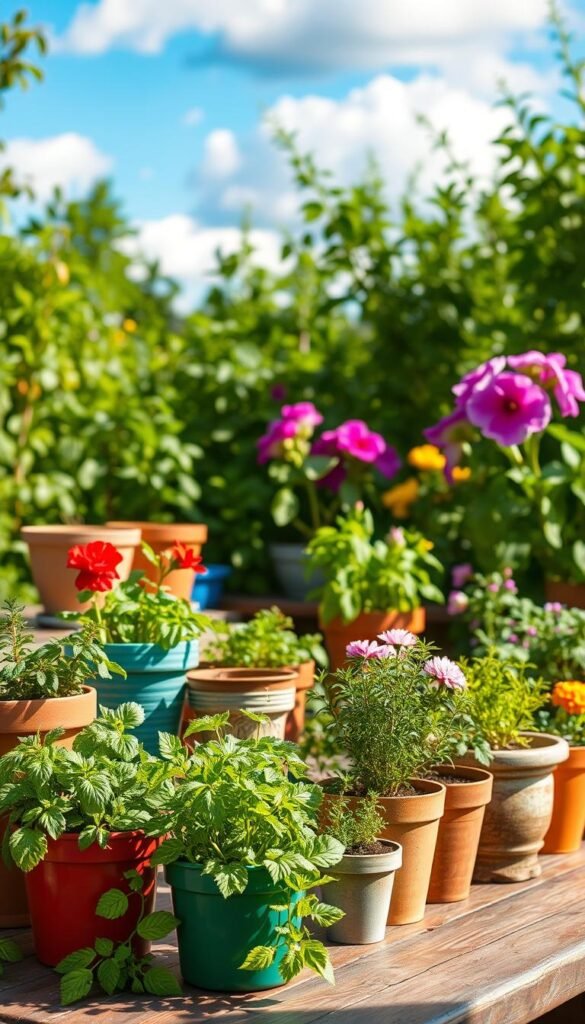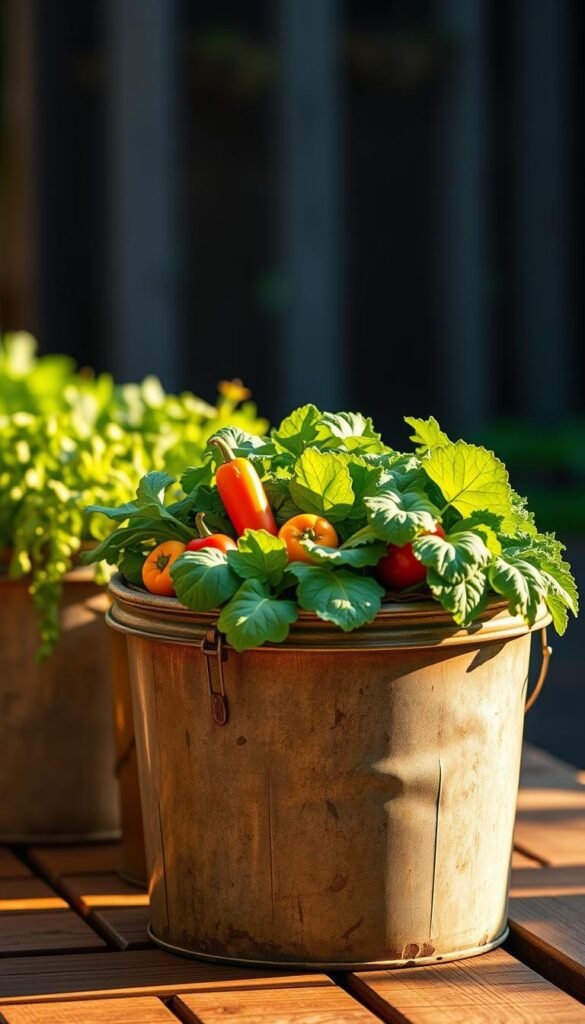Do you dream of harvesting fresh veggies but lack backyard space? You’re not alone. Urban dwellers and renters are reimagining their balconies, patios, and windowsills with versatile container setups. One popular method uses five-gallon buckets—affordable, portable, and perfect for beginners.
Why choose buckets? Their size balances root depth with mobility. Move plants to chase sunlight or shield them from storms. Just drill holes in the bottom for drainage—a simple step to prevent soggy roots. Overwatering is the top mistake new gardeners make, so let the soil dry slightly between waterings.
Tomatoes, peppers, and pole beans flourish in these containers. Even compact eggplants thrive! Pair them with nutrient-rich soil, and you’ll see sprouts in weeks. Best of all, this approach works for renters or those with limited time.
Ready to dig deeper? We’ll explore how to pick buckets, craft the ideal soil blend, and keep pests at bay. Let’s turn your small space into a green oasis!
Key Takeaways
- Ideal for urban spaces, five-gallon buckets offer flexibility and mobility.
- Proper drainage prevents root rot—drill holes before planting.
- Tomatoes, beans, and peppers grow exceptionally well in this setup.
- Monitor soil moisture to avoid overwatering your portable garden.
- Customizable soil mixes boost plant health and yield.
Getting Started with Container Gardening
Limited outdoor areas? Containers turn patios, balconies, and even staircases into thriving green zones. This method lets you control soil quality and sunlight exposure while avoiding weeds. Whether you’re growing herbs or tomatoes, the right setup makes all the difference.

Understanding the Basics of Container Gardening
Small-space growing works because plants focus energy on fruit production instead of spreading roots. Use containers at least 12 inches deep for most veggies—this prevents overcrowding. Drainage is non-negotiable: one poorly drained pot can drown an entire crop.
Soil matters more than you think. Skip dense garden dirt—it compacts easily. Mix peat moss, perlite, and compost for lightweight, nutrient-rich blends. Test moisture daily by sticking your finger 2 inches deep. If it’s dry, water thoroughly until liquid flows from the bottom holes.
Selecting the Right Buckets and Materials
Five-gallon containers from hardware stores work perfectly. Avoid reused chemical barrels—they might leach toxins. Drill 5-8 quarter-inch holes in each base for drainage. Line the bottom with coffee filters to keep soil from escaping.
Garden expert Lisa Nguyen advises: “Double-check bucket colors. Dark ones absorb heat—great for cool climates but risky in hot summers.” Pair lighter-colored pots with trellises for vining plants like cucumbers. This maximizes vertical space without sacrificing mobility.
Bucket Gardening 101: Grow Vegetables in 5-Gallon Containers – The Essentials
Transforming tight spaces into lush gardens starts with smart plant choices. Some crops naturally adapt better to confined roots, while others struggle. Let’s explore which options deliver the best results and how to set them up for success.
Choosing Suitable Vegetables for Buckets
Compact varieties outperform traditional ones in limited spaces. ‘Early Girl’ tomatoes and ‘Provider’ bush beans thrive with minimal root room. Leafy greens like spinach need just 6 inches of soil depth, making them perfect for shallow setups.

- 1 tomato or pepper per container
- 3-4 carrot or radish plants
- 6-8 lettuce or spinach seedlings
Urban gardener Carlos Rivera notes: “Overcrowding stunts growth—give roots breathing room for higher yields.” Pair climbing plants like cucumbers with trellises to maximize vertical space.
Establishing Proper Drainage and Soil Mix
Roots drown without oxygen. Mix 60% potting soil, 30% compost, and 10% perlite for ideal drainage. This blend retains moisture while letting excess water escape through drilled holes.
For potatoes, try fabric grow bags instead of rigid containers. They air-prune roots naturally and fold flat when empty. Avoid standard garden soil—it compacts into concrete-like density after repeated watering.
Check moisture levels every morning. If the top inch feels dry, water slowly until liquid seeps from the base. Consistent hydration prevents blossom-end rot in tomatoes and peppers without waterlogging delicate roots.
Design and Maintenance Tips for Your Container Garden
Elevate your small-space growing game with clever design choices and smart upkeep routines. Whether you’re nurturing herbs or tomatoes, these strategies keep plants healthy while making your setup visually appealing.
Watering, Fertilizing, and Planting Techniques
Water plants at the base using a narrow-spout can. This prevents soil erosion and keeps leaves dry, reducing disease risk. Slow-release fertilizers work best—mix pellets into soil during planting for steady nutrient flow.
Check moisture daily by pressing a finger into the dirt. If the top inch feels dry, water until it drains from the bottom. For leafy greens, plant seeds ¼ inch deep. Tomatoes and peppers need deeper holes—bury stems up to their first leaves for stronger roots.

Creative Ideas for Maximizing Garden Space
Repurpose old pallets into vertical herb walls or stack wooden crates for tiered plant displays. “Hang baskets of strawberries near windows—they’ll ripen faster with reflected heat,” suggests urban gardener Mia Torres.
Use window boxes for dwarf kale or colorful lettuce varieties. Paint recycled trash cans for a cohesive look, or try fabric grow bags for potatoes. Rotate containers weekly to ensure even sun exposure, especially for light-loving plants like peppers.
Combat pests naturally: sprinkle coffee grounds around tomatoes or spray diluted soap water on aphids. For heavy feeders like squash, add compost tea every two weeks during peak growth.
Conclusion
Your journey to fresh produce starts with a single container. Whether you’re arranging self-watering setups or testing vertical raised bed concepts, flexibility defines this approach. Remember: drainage holes and airy soil blends keep roots happy, while consistent watering fuels growth.
Mix leafy greens with colorful peppers for visual appeal. Try potatoes in fabric bags or cherry tomatoes in lighter-colored pots. Rotate planters weekly to balance sun exposure—your balcony can rival traditional plots with smart spacing.
Experimentation unlocks success. Swap crops seasonally or add trellises for climbing beans. Urban spaces evolve into edible landscapes when you adapt to weather shifts and sunlight patterns.
Ready to transform unused corners? Grab those containers, mix your soil, and let your green thumb shine—your mini oasis awaits!
